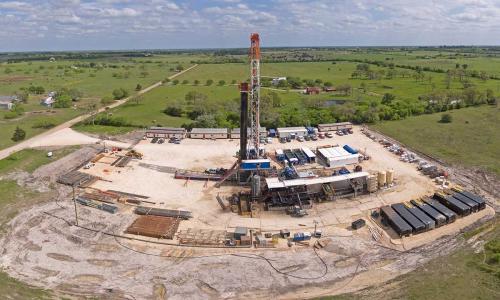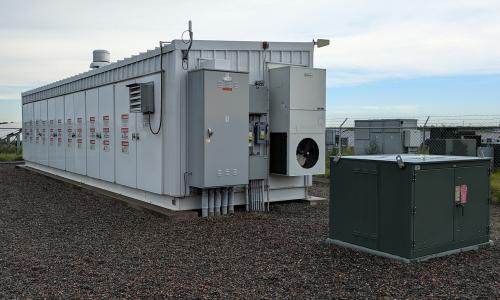Despite decades of extraction and use, the estimated size of the US natural gas resource has steadily risen since the 1990s, largely buoyed by the increased feasibility of extracting gas from unconventional deposits.
Unconventional natural gas, which includes shale gas, tight gas, coal bed methane, and methane hydrates, has been more difficult and costly to exploit than conventional deposits, until recently.
Such sources could help close the growing gap between domestic production and consumption in the United States, but they present greater environmental challenges in their production.
The Energy Information Administration currently estimates the US unconventional gas resource base to be 2,203 trillion cubic feet. Of that, 167 trillion cubic feet are considered proven reserves—recoverable under current economic and operational conditions [1].
Shale gas
Unlike conventional gas, which resides in highly porous and permeable reservoirs and can be easily tapped by standard vertical wells, shale gas remains trapped in its original source rock, the organic-rich shale that formed from the sedimentary deposition of mud, silt, clay, and organic matter on the floors of shallow seas.
The first well in the United States drilled specifically to produce natural gas tapped into a shale gas deposit in Fredonia, New York in 1821 [2]. Because of the very low permeability of these shales, however, conventional extraction using vertical wells proved not to be cost-effective, as more easily exploited deposits were found elsewhere.
Today, shale gas is the fastest growing natural gas resource in the United States and worldwide as a result of several recent developments. Advances in horizontal drilling technology allow a single well to pass through larger volumes of a shale gas reservoir and thus produce more gas.
The development of hydraulic fracturing technology (also known as hydrofracturing, hydrofracking, or simply fracking) has also improved access to shale gas deposits. This process requires injecting large volumes of water mixed with sand and fluid chemicals into the well at high pressure to fracture the rock, increasing permeability and production rates. In addition to these technological advances, high natural gas prices between 2001 and 2008 have provided further incentive to develop the shale gas resource. However, the resulting increase in shale gas combined with the recent economic recession has resulted in a dramatic decline in gas prices since 2008.
To extract shale gas, a production well is drilled vertically until it reaches the shale formation, at which point the wellbore turns to follow the shale horizontally. Steel tubing, called “casing,” is inserted into the well to keep it open and protect the integrity of the wellbore. Cement is then pumped into the well and forced up the outside of the steel casing to seal the well and try to prevent natural gas, fracking fluids, chemicals, and produced water from leaking into groundwater supplies.
After drilling and well casing is completed, small explosive charges are detonated in the horizontal portion of the well to create holes in the casing at intervals where hydraulic fracturing is to occur. In a hydraulic fracturing operation, the fracturing fluid is pumped in at a carefully controlled pressure to fracture the rock out to several hundred feet from the well. Sand mixed with the fracturing fluid acts to prop these cracks open when the fluids are subsequently pumped out. After fracturing, gas will flow into the well bore and up to the surface, where it is collected.
As of 2011, slightly more than 39 percent of US natural gas reserves, or 132 trillion cubic feet, were in shale deposits, mostly in Texas, Louisiana, Arkansas, and Pennsylvania [3]. These deposits are located throughout the United States, typically where conventional gas resources also occur. Recently, the Marcellus Shale in Pennsylvania and West Virginia, the Barnett Shale in Texas, the Hanesville shale in Louisiana and Texas, and the Fayetteville shale in Arkansas have all seen a significant growth in natural gas production.
Tight gas sandstone
Tight gas refers to natural gas that has migrated into a reservoir rock with high porosity but low permeability.
These types of reservoirs are not usually associated with oil and commonly require horizontal drilling and hydraulic fracturing to increase well output to cost-effective levels.
Coalbed methane
Natural gas is often collocated with petroleum, but it can also be found trapped within coal deposits.
Methane has traditionally posed a hazard to underground coal miners, as the highly flammable gas is released during mining activities. Otherwise inaccessible coal seams can also be tapped to collect this gas, known as coalbed methane, by employing similar well-drilling and hydraulic fracturing techniques as are used in shale gas extraction. As of 2010, slightly more than 6 percent of US natural gas reserves, or 17.5 trillion cubic feet, were in coalbed methane deposits, mostly in Colorado, New Mexico, and Wyoming [4].
Coalbed methane deposits have also attracted interest for their potential for carbon sequestration. Injecting carbon dioxide (CO2) into hard-to-mine coal seams would cause the CO2 to displace the methane locked within the coal, enhancing the recovery of the natural gas resource while storing the CO2 where it would not contribute to global warming.
Methane hydrates
Methane hydrates, which consist of methane molecules trapped in a cage of water molecules, occur as crystalline solids in sediments in arctic regions and below the floor of the deep ocean. Although they look like ice, methane hydrates will burn if lit.
Methane hydrates are the most abundant unconventional natural gas source and also the most difficult to extract. While there is much uncertainty about the total size of the methane hydrate resource, it is conservatively estimated to be 4,000 times the amount of natural gas consumed in the United States in 2010. However, the technical challenges of economically retrieving the resource are significant, and only a small fraction of the total resource is found in high enough concentrations to be feasibly captured [5].
There is also a significant risk that rising temperatures from global warming could destabilize methane hydrate deposits, releasing the methane — a potent greenhouse gas — into the atmosphere, and further exacerbating the problem [6].
Biogenic gas
Certain types of bacteria, known as methanogens, can produce methane, the chief component of natural gas, in the process of breaking down organic matter in an oxygen-free environment.
This type of gas is call “biogenic” to differentiate it from the “thermogenic” or fossil gas produced from organic material buried in the Earth's crust at high temperatures and pressures. The properties of biogenic methane are identical to those of thermogenic methane.
Livestock manure, food waste, and sewage are all potential sources of biogenic gas, or biogas, which is usually considered a form of renewable energy.
One study has estimated that the US technical potential from livestock manure alone could supply 1 percent of the country’s energy needs and lead to a 4 percent reduction in US greenhouse gas emissions [7]. Already, dozens of US farmers, particularly in the Midwest, have invested in anaerobic digesters and generators to produce electricity and heat (and extra farm revenue) from livestock wastes. Small-scale biogas production is a well-established technology in parts of the developing world, particularly Asia, where farmers collect animal manure in vats and capture the methane given off while it decays.
Landfills offer another under-utilized source of biogas. When municipal waste is buried in a landfill, bacteria break down the organic material contained in garbage such as newspapers, cardboard, and food waste, producing gases such as carbon dioxide and methane. Rather than allowing these gases to go into the atmosphere, where they contribute to global warming, landfill gas facilities can capture them, separate the methane, and combust it to generate electricity, heat, or both.
References:
[1] Energy Information Administration. 2012. Annual Energy Review. Table 4.1 Technically Recoverable Crude Oil and Natural Gas Resource Estimates, 2009.
[2] National Energy Technology Laboratory (NETL). 2009. Modern shale gas development in the United State: A Primer. Prepared by Ground Water Protection Council and ALL Consulting.
[3] Energy Information Administration. 2010. Shale Gas Proved Reserves as of Dec. 31.
[4] Energy Information Administration. 2010. Coalbed Methane Proved Reserves as of Dec. 31.
[5] United States Geological Survey. 2013. Gas Hydrates Primer.
[6] Lawrence Livermore National Laboratory. 1999. Methane Hydrate: A Surprising Compound.
[7] Cuellar, Amanda D. and Michael E. Webber. 2008. Cow power: the energy and emissions benefits of converting manure to biogas.




